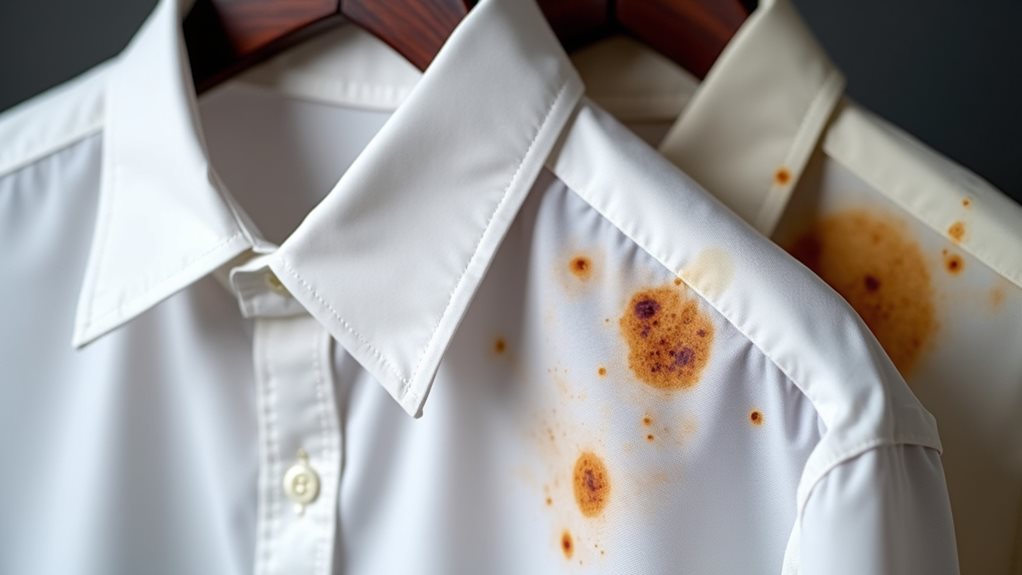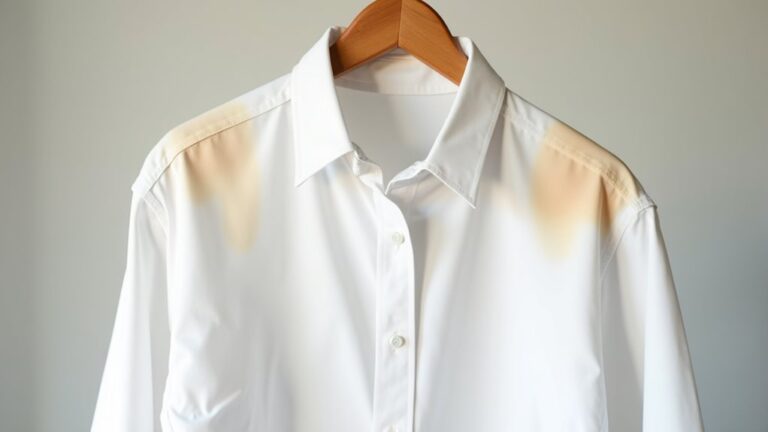Yes, dry cleaning can remove many stubborn stains that regular washing can’t touch, especially oil-based stains like grease, makeup, and cooking oils that dissolve beautifully in specialized solvents. You’ll have the best luck with fresh stains – I learned this the hard way after letting a salad dressing spot sit for weeks! Protein-based stains like sweat and blood also respond well to enzyme treatments, though set-in or heat-damaged stains might only lighten rather than disappear completely, and there’s so much more to discover about maximizing your success.
How Dry Cleaning Works to Remove Stains
When I first discovered how dry cleaning actually works, I’ll admit I was pretty amazed by the science behind what seems like such a simple process 🧪.
The dry cleaning process relies on specialized solvents used instead of water, with perchloroethylene being the star player that dissolves oil-based stains at the molecular level.
Unlike water-based washing, dry cleaning uses powerful chemical solvents like perchloroethylene to break down stubborn oil stains at their molecular core.
Professional cleaners target specific spots first, then use enzyme-based cleaning agents that break down protein stains like sweat and blood without compromising delicate fabrics.
What really impressed me was watching how these solvents maintain fabric integrity while tackling tough stains that would normally require harsh scrubbing.
The gentle approach means your favorite silk blouse won’t shrink or fade, yet stubborn wine and coffee stains disappear like magic through this careful stains dry cleaning technique.
After the solvent treatment, cleaners use steam and pressing to refresh and reshape garments, completing the restoration process that makes clothes look crisp and new again.
Types of Stains Dry Cleaning Can Effectively Remove
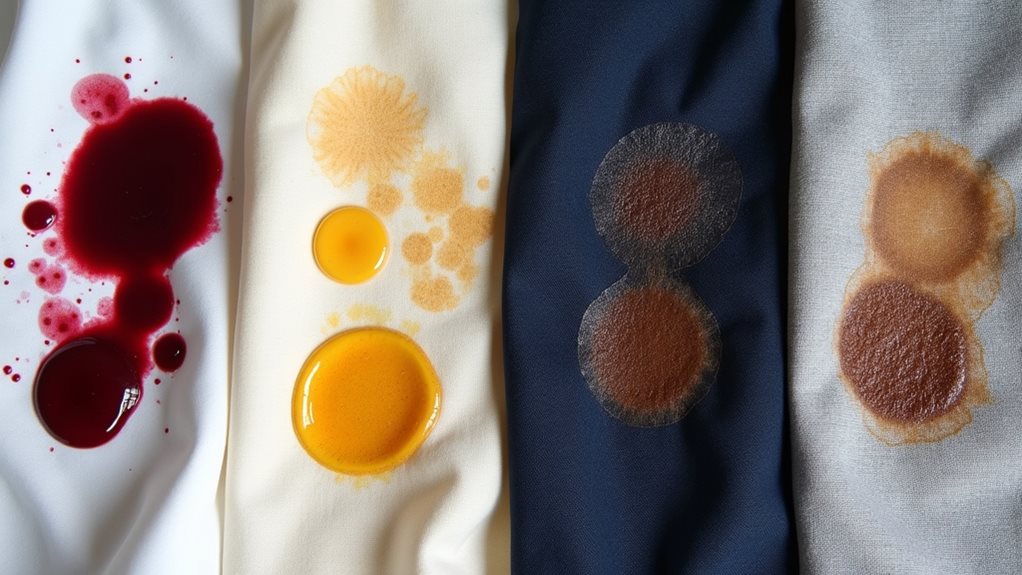
You’ve probably wondered which stubborn stains actually stand a chance against professional dry cleaning, and honestly, the answer might surprise you with how effective those specialized solvents can be.
When you’re dealing with oil and grease stains from cooking mishaps or that inevitable salad dressing disaster (we’ve all been there 😅), dry cleaning becomes your fabric’s best friend because those solvents dissolve greasy residues without breaking down delicate fibers.
Protein-based stains like sweat marks from your favorite blazer or blood spots from minor accidents also respond beautifully to dry cleaning’s enzyme treatments, which literally digest the proteins while keeping your garments intact.
Makeup stains, which can be particularly tricky to remove at home, are another area where chemical solvents excel since they can break down the oils and pigments in cosmetics without damaging delicate fabrics.
Oil and Grease Stains
Although water-based detergents might leave you frustrated when tackling that stubborn cooking oil splatter on your favorite blouse, dry cleaning’s specialized solvents work like molecular matchmakers, dissolving those greasy culprits with remarkable precision.
Whether you’ve battled motor oil from your weekend garage adventures, sunscreen mishaps from beach days, or cosmetic stains from hurried morning routines, professional dry cleaning offers hope where regular washing fails.
These powerful solvents penetrate deep into delicate fabrics, lifting away lipid-based residues without compromising your garment’s integrity or vibrant colors.
Here’s the golden rule I’ve learned the hard way: speed matters tremendously in stain removal success. The sooner you get that oil-stained item to your trusted cleaner, the better your chances of complete restoration become.
This effectiveness stems from the fact that soap and water rely on polar molecular interactions that simply cannot break down non-polar substances like oils and grease at the molecular level.
Protein-Based Stain Removal
Moving beyond greasy mishaps, protein-based stains present their own unique battlefield where dry cleaning’s enzyme arsenal truly shines.
You’ve probably discovered that traditional washing machines can’t tackle these stubborn marks effectively, leaving you frustrated with lingering stains on delicate fabrics.
Professional dry cleaning uses powerful enzyme solutions for specialized treatment that breaks down protein bonds completely.
Here are common protein stains that respond beautifully to thorough treatment:
- Sweat stains from your favorite silk blouse
- Blood spots from cooking mishaps
- Dairy spills like yogurt or milk
- Egg white disasters from breakfast prep
The secret lies in immediate treatment – the sooner you bring protein-based stains to professionals, the better your chances for effective removal without fabric damage.
However, protein-based stains like blood or sweat may prove more challenging when they’ve been heat-set through previous washing attempts.
Oil-Based and Grease Stains: Why Dry Cleaning Excels
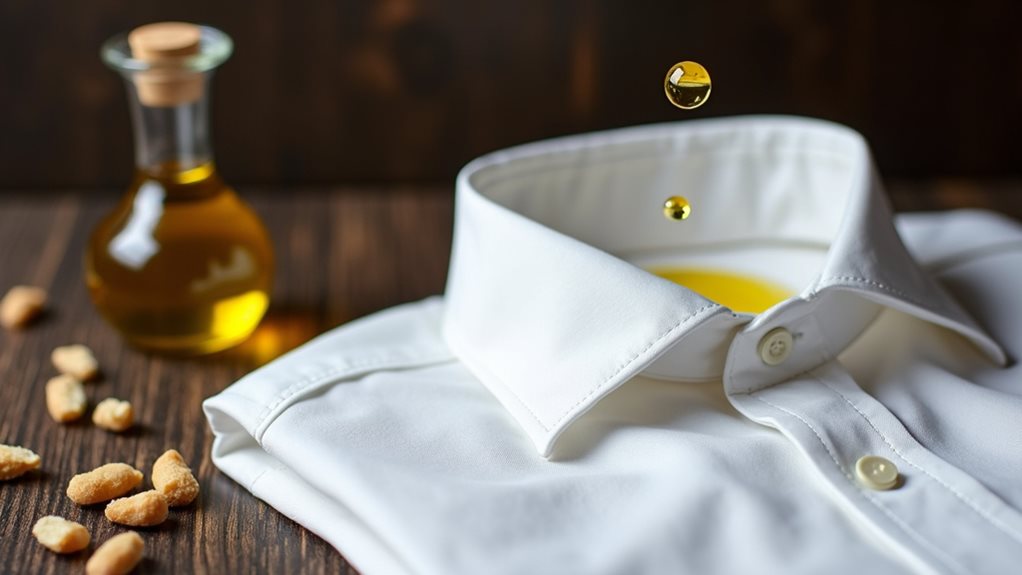
When I accidentally dripped olive oil down my favorite silk blouse during last week’s dinner party, I’ll admit my first instinct was pure panic – until I remembered why dry cleaning exists in the first place.
Unlike traditional laundering that struggles with oil-based stains, dry cleaning solvents actually dissolve grease at the molecular level, penetrating deep into delicate fabrics without the fabric-damaging heat that can permanently set stains.
You’ve probably experienced this frustration yourself – throwing an oil-stained shirt into your washing machine, only to watch it emerge with the grease still stubbornly clinging to the fibers.
Professionals understand that specialized solvents break down lipid bonds effectively, making even stubborn set-in stains surrender while preserving your garment’s fabric integrity and original beauty.
The success of stain removal depends on several factors including the type of oil, how long the stain has been set, and whether any previous attempts at removal have been made.
Protein-Based and Tannin Stains: Professional Treatment Methods
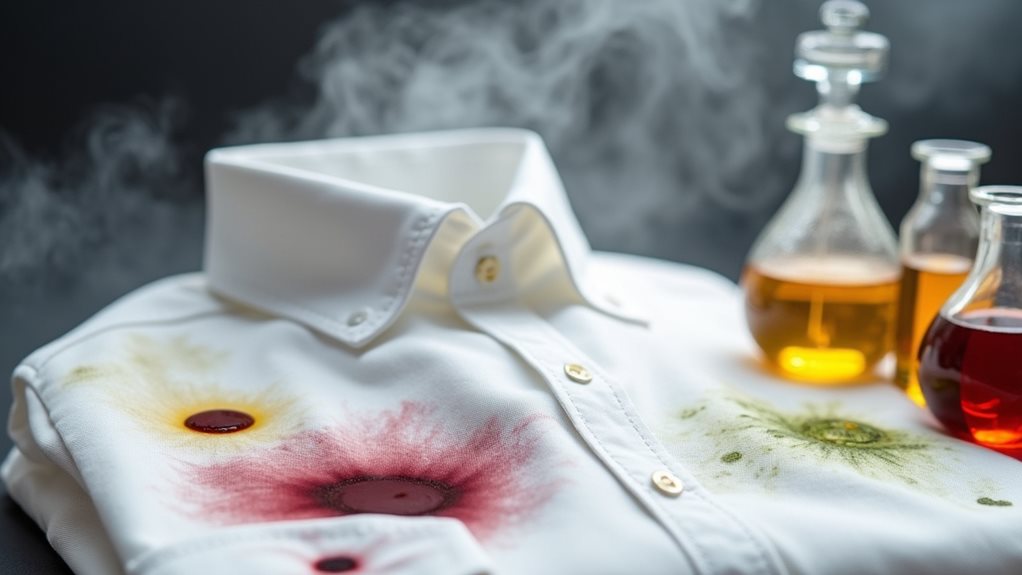
While oil stains might surrender easily to dry cleaning solvents, protein-based stains and tannin stains present an entirely different challenge that requires a completely different arsenal of professional weapons.
Your professional dry cleaner becomes your strategic partner when facing these stubborn culprits.
Here’s how they tackle these tricky stains:
- Powerful enzyme solutions break down protein bonds from sweat, blood, and dairy without harming delicate fabrics.
- Specialized dry cleaning solvents neutralize tannin stains from red wine and coffee before they set permanently.
- Deep penetration techniques reach fabric fibers that traditional washing can’t touch.
- Expert assessment guarantees proper treatment methods for successful removal.
Professional dry cleaners use specialized pre-treatment techniques to break down protein-based stains like blood, making them particularly effective for delicate materials that cannot withstand traditional home washing methods.
Limitations: When Dry Cleaning May Not Remove Stains
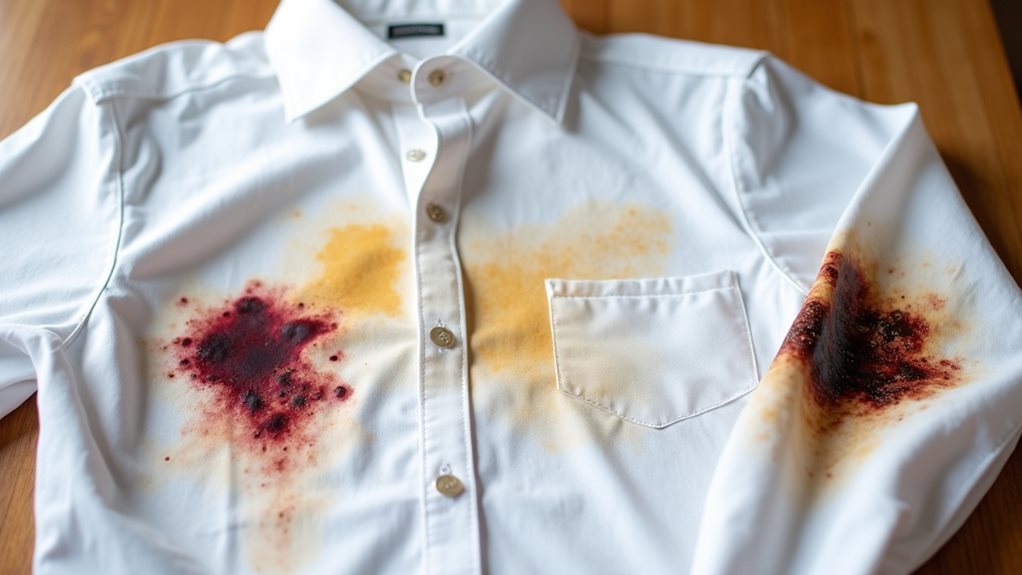
While dry cleaning works wonders on many stubborn marks, you’ll find that some stains simply won’t budge, especially those old set-in spots that have basically become best friends with your fabric’s fibers over the years.
I learned this the hard way when I brought my favorite silk blouse with a months-old wine stain to three different cleaners, only to discover that time had made that burgundy mark practically permanent 😅.
The reality is that delicate fabrics like silk, vintage wool, or intricate beadwork can be too fragile for the aggressive treatments needed to tackle tough stains, leaving you with a choice between preserving the garment’s integrity or risking damage for stain removal.
Additionally, certain substances like ink stains, paint, or very old set-in marks may prove more challenging to remove completely, even with professional dry cleaning techniques.
Old Set-In Stains
Although professional dry cleaners work miracles on fresh spills and everyday mishaps, they face their greatest challenge when confronting old, set-in stains that have had months or years to form an unbreakable bond with your favorite garments.
Here’s what you should understand about old set-in stains and dry cleaning’s limitations:
- Time works against you – The longer stains sit untreated, the deeper they penetrate fabric fibers, making them exponentially more difficult to remove.
- Preserving fabric integrity becomes priority – Aggressive stain removal on delicate fabrics risks permanent damage.
- Expectations need adjustment – Dry cleaning can tackle these stains but may only lighten rather than completely eliminate them.
- Information helps – Sharing stain details with your cleaner improves chances of removing stubborn marks.
Sometimes accepting partial improvement beats attempting risky home remedies that could worsen things. While chemical solvents used in dry cleaning can dissolve many stubborn stains that water-based cleaning cannot handle, even these powerful solutions have their limits when confronting stains that have had years to set into fabric fibers.
Delicate Fabric Risks
When your grandmother’s vintage silk blouse develops a mysterious stain, or your favorite cashmere sweater suffers an unfortunate wine spill, you’re entering territory where even the most skilled dry cleaners must proceed with extreme caution.
Delicate fabrics like silk, wool, and leather present unique challenges that can make professional dry cleaners hesitate before attempting aggressive stain removal techniques.
The harsh reality? Sometimes preserving garment integrity takes priority over complete stain elimination.
Your silk blouse’s fabric fibers are incredibly vulnerable to chemical damage, color bleeding, and texture changes during intensive treatment.
Professional dry cleaners often face treatment limitations where they’ll choose to lighten a stain rather than risk destroying the entire garment.
The risk of damage simply outweighs the potential benefits, leaving you with a choice between a faded mark or a ruined piece.
Additionally, the traditional PERC solvents used in dry cleaning can be particularly harsh on delicate fabrics, making gentle stain removal even more challenging for professionals who must balance effectiveness with fabric preservation.
Tips for Better Stain Removal Results at Dry Cleaners
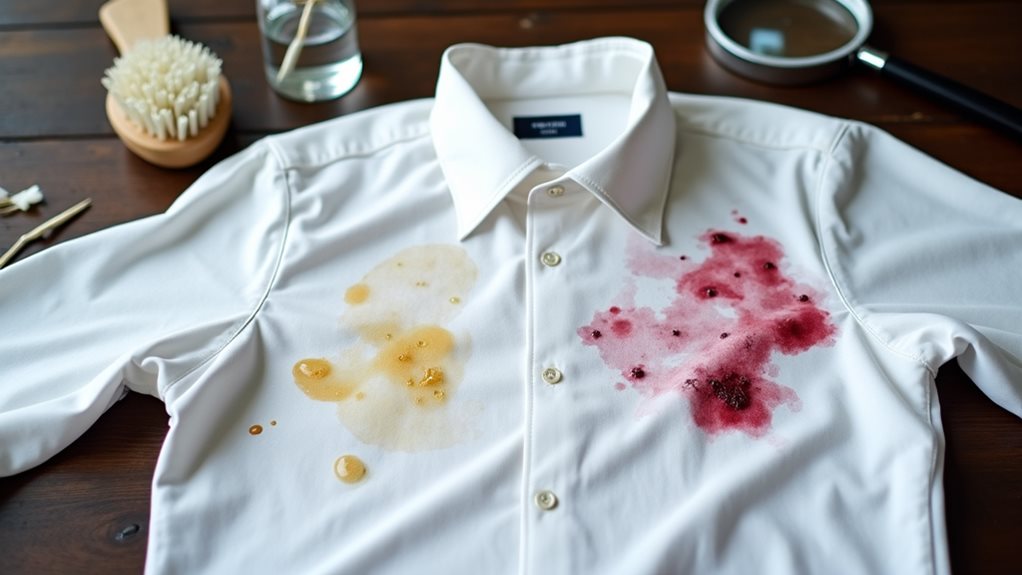
How many times have you rushed to the dry cleaner with a stained garment, only to mumble something vague about “a spill” and hope for the best?
I’ve been there too, and trust me, your dry cleaners need more intel to tackle even stubborn stains effectively.
Here’s how to maximize your professional stain removal success:
- Tell the whole story – Detail what caused the stain and when it happened, so dry cleaners use the right solvents for removing the stain.
- Rush there immediately – Don’t let that stain without treatment set deeper into fibers.
- Be careful with home remedies – Skip DIY fixes that might complicate oil stains or damage delicate fabrics.
- Avoid heat – Never put stained items in the dryer; heat sets stains permanently.
Remember that chemical solvents used in dry cleaning are particularly effective at breaking down oil-based stains, grease, and makeup that water-based washing simply can’t handle.
Your honesty helps professionals choose the perfect approach!

